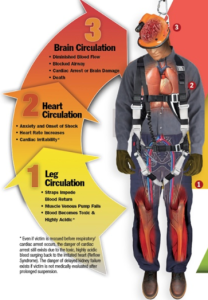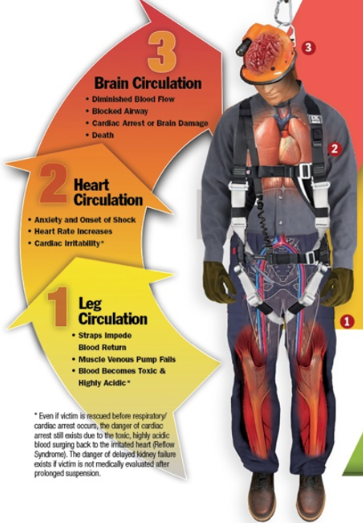Personal fall protection is important when you perform job tasks at heights. If you fall and your fall protection gear saves you, you may be suspended in the air for several minutes. During this time, blood can pool in your legs, deprive the brain of oxygen, and cause orthostatic intolerance, or suspension trauma. If you are not rescued promptly and with correct procedures, suspension trauma can have lasting effects and even cause death.
You have probably seen examples of orthostatic intolerance without knowing the term. When soldiers lock their legs straight at attention or nervous bridegrooms stand too long at the altar, they experience orthostatic intolerance and faint. Because the muscles of the leg are not moving enough to pump the blood back up to the heart and brain, it pools in the legs and causes the person to faint. With the body in a horizontal position, the blood flow is restored, and the person can recover.
If you are suspended in fall protection gear, you will be hanging straight up with your feet dangling. Holding this position for a long period of time can lead to orthostatic intolerance and you may faint. You will not, however, fall to a horizontal position, and your blood will continue to pool. Your inactive leg muscles will use up the oxygen in the pooled blood and begin to burn fats to stay alive. If you are suddenly put into a horizontal position, such as during a rescue, this deoxygenated blood can flow back into the body (reflow syndrome) and cause damage to your organs, brain, and even cause your heart to stop.
To avoid suspension trauma when your fall protection is in use, first be aware of the symptoms you may experience such as faintness, nausea, dizziness, sweating, paleness, and a narrowing of vision. The risk of experiencing suspension trauma can be affected by the weather conditions, the shock and injuries sustained during your fall, blood loss, and your overall health.
Learn techniques that can help pump your leg muscles such as tensing and relaxing them and straightening them and pulling them up to a “sitting position.” Maintaining these exercises may be very difficult after a fall, so consider adding foot straps to your fall protection gear to support the legs and give you something to strain and push against.
Pay close attention to the rescue procedures that are appropriate to suspension trauma and to prevent reflow syndrome. Have a plan in place to rescue suspended workers quickly and get them immediate medical attention. When rescuing a suspended worker, do not lay them flat into a horizontal position. Keep them sitting up with their legs straight out in front of them. Keep the worker calm and quiet and monitor them constantly so they do not faint and fall into a horizontal position. Get a rescued worker immediate medical attention and ensure that medical personnel are aware of the possibility of suspension trauma.
Don’t leave safety hanging. Learn proper prevention and prompt rescue techniques to prevent suspension trauma.


